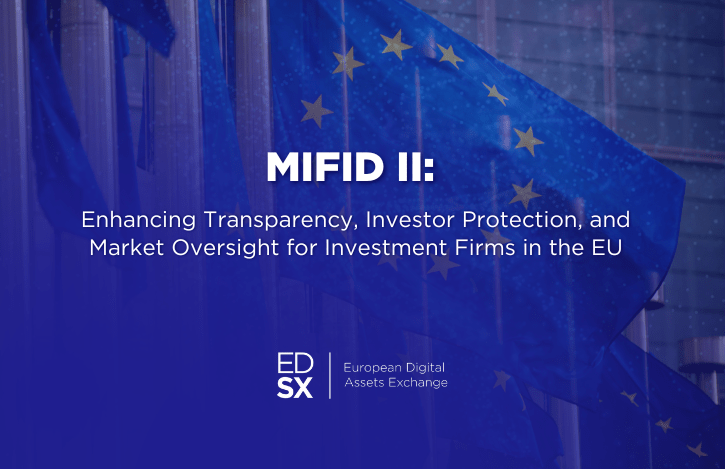Following the 2008 financial crisis, the European Union (EU) introduced the Markets in Financial Instruments Directive (MiFID) and its subsequent revision, MiFID II, with a primary focus on strengthening investor protection, enhancing market regulation, and improving the oversight of financial markets. These comprehensive frameworks have ushered in substantial changes, profoundly impacting the investment landscape. MiFID II, as an updated version, has introduced various measures to enhance transparency, bolster the conduct of business, and enforce rigorous governance requirements for investment firms operating within the EU.
Under MiFID II, there is a stronger focus on investor protection and conduct of business. Compliance officers play a crucial role in ensuring that staff understand and comply with the regulatory requirements when selling or advising on MiFID financial instruments. Strict controls over remuneration incentivize staff to adopt prudent financial positions that align their interests with those of the clients. Additionally, the staff are required to issue periodic suitability assessments to clients to ensure the appropriateness of the portfolio management and financial advice given.
MiFID II grants authorities more power to control financial markets, ensuring stability. It allows investigating and restricting unsound financial instruments. Authorities use various tools for regulatory control, including emissions allowances and structured deposits. Additionally, previously exempt investment firms are now within the regulatory framework. As a result, some firms seek authorization under MiFID II before issuing investment instruments for potential clients. Investment firms have standardized the authorization process across Europe, streamlining it and ensuring consistent requirements.
MiFID II brought the Organized Trading Facility (OTF), designed for non-equity instruments like bonds, structured products, and derivatives. It expanded transaction reporting, requiring firms to report more information, including identifying those responsible for investment decisions. These measures collectively enhance transparency and regulatory oversight in the financial markets, fostering a more accountable and informed investment environment.
In addition to MiFID II, the Investment Firms Regulation, and Investment Firms Directive (IFR/IFD) were introduced. These regulations introduce prudential requirements tailored to the risks associated with different types of investment firms. The focus is on mitigating risks faced by firms and potential harm to clients and the market. The IFR/IFD framework classifies investment firms into different categories, determining prudential requirements based on their classification. Systemic firms and those performing bank-like activities remain subject to existing prudential requirements, while other firms move to the IFR/IFD regime with specific requirements based on their classification.
The classification of firms is determined by the calculation of K-factors. From this calculation, the firms will need to have the funds required to cover risks to customers, risks to the market and risks to the firm. Liquidity requirements and disclosures related to risk management objectives, governance, and own funds composition are also part of the reporting obligations for investment firms.
Overall, MiFID II and the IFR/IFD framework have significantly transformed the regulatory landscape for investment firms in the EU. The emphasis on investor protection, transparency, and prudential requirements aims to create a more secure and accountable financial market environment.
With stability in mind, the MiFID and the IFR/IFD frameworks were created to strengthen transparency in the financial markets. It profoundly transformed the regulatory landscape for investment firms in the EU with its requirements extending beyond the original limited transparency requirements to cover investment instruments beyond equities in order to regulate non-equity instruments. The regulation ensures that pre-trade and post-trade disclosures relate to orders and transactions on trading venues. However, even during its most recent update in 2018, the MiFID II did not address crypto assets.
The recent introduction of MiCA regulations brought crypto assets under regulation, impacting MiFID II. MiCA enforces transparency, investor protection, and market integrity standards for crypto services, aligning with MiFID II objectives. This expansion ensures a comprehensive framework for the evolving crypto-asset market while preserving MiFID II’s core objectives. The implementation of MiFID II and the IFR/IFD framework marks a new era of regulation for EU investment firms, prioritizing investor protection and transparency. The recent addition of MiCA further enhances regulatory oversight and promotes market integrity, safeguarding investors as the financial industry evolves. These frameworks ensure a secure and accountable financial environment, supporting sustainable growth in the EU’s financial markets.

Based in Zug, the platform is fully compliant with all Swiss laws related to financial intermediaries, banking, anti-money laundering, and organized trading facilities. Among its core values, there are innovative solutions through blockchain technology, which ensures security and liquidity.
EDSX is the first platform in Europe with primary and secondary markets for both institutional and retails. EDSX is a pioneering platform that employs the world’s leading technology to globally list security tokens in both primary and secondary markets, listing digital securities of real financial instruments to the public with a decentralized peer-to-peer exchange. Our goal is to fully engage every aspect of the financial revolution.
Do you have a question for us?
Send your query here:
[email protected]

